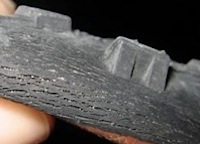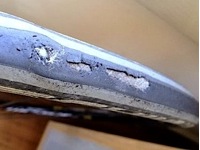7 Signs to Replace Your Bicycle Tires
By Christian Woodcock
Tires are the consumable we go through most when riding regularly. Whether it is from long term wear, or from rolling through some idiot's broken glass bottle discarded carelessly onto the side of the road, tires need to be constantly checked and replaced.
When you start clocking up the miles every week you will be amazed how quickly your tires do wear down or fail completely. Pre-empting catastrophic failure while on a long ride "out the back" can save a lot of frustration and walking. Read on for some tips when checking your tires and deciding on a replacement time.
You can find new tires at South Shore Cyclery.
When you do change your tires, be sure to recycle your old tires and tubes. Many stores will offer this as a free or cheap service with your tire purchase. This will keep them out of landfill and give your old rubber new life for uses such as rubber ground surfaces for playgrounds.

 TIP: The only part of your road bike that actually contacts the ground is a patch of rubber the size of your thumb. It is extremely important when riding in a bunch or descending at speed to be aware of this and be confident your tires are in good nick.
TIP: The only part of your road bike that actually contacts the ground is a patch of rubber the size of your thumb. It is extremely important when riding in a bunch or descending at speed to be aware of this and be confident your tires are in good nick.
1. Worn down tread
Easy to spot. On an MTB or general purpose tire, the absence of any remaining tread is a good indicator that it is ready to be replaced.
2. Flat spot along the center of the tire
Road tires don't have a noticeable tread pattern, but one way to notice wear is the formation of a flat surface down the centre line and a squaring off to the side walls. Using a tire on a stationary trainer speeds this up. Once this 'ridge' appears you may notice you get more punctures, it will be harder to maintain top speed and cornering will become unpredictable. When a worn tire is affecting bike performance it's time to replace it.
3. Cracked rubber
Really more for the bike kept under the house unridden for five years. Rubber becomes brittle with age and can be dangerous if not replaced. If cracks are appearing (they often start on the sidewalls) throw the tire away and get a new one.
4. Constant flats
On a road bike a good indicator is a sudden increase in flats. If you suddenly experience an increase in punctures, check your tires for wear, holes or even make sure they are seated properly. If you've only gotten one flat you may not need to replace your tire, just follow these instructions to fix your flat tire and you might be all set.
5. Cuts and holes
The edge of the road is full of all sorts of junk and debris, particularly after rain. Even if you don't get an immediate puncture you will notice a constant build-up of small nicks and cuts. It is a good idea to check if any of these holes have punctured through the casing, and if so you may need to replace the tire. A tube inflated to 100 PSI will squeeze through any hole available, which usually ends up as a puncture.
Another important thing to look out for is a sidewall cut or tear near the bead of the tire. This can result in a blow out and any tire with a compromised casing (particularly near the bead) should be discarded immediately.

6. Worn down to the casing
As previously mentioned, the lack of a discernible tread pattern on many road tires means it may be difficult to ascertain wear. Once past the flat spot mentioned above you may wear down to the nylon threads (TPI) which reinforce and shape the casing. If you see white fibres throw the tire away and get a new one before you hurt yourself!
 TIP: Many tires actually have 'wear indicators'. This could be a groove or small dimple in the tread. Once this disappears it is time for a new tire. Some brands use a different colour rubber to indicate the level of wear.
TIP: Many tires actually have 'wear indicators'. This could be a groove or small dimple in the tread. Once this disappears it is time for a new tire. Some brands use a different colour rubber to indicate the level of wear.
7. Bubbles or deformities
I went out for an otherwise uneventful ride on a stinking hot summer day and was unaware there was a problem till the following day when 3 miles out there was a regular bump...bump....bump. On inspection the tire had seemingly melted, thinned out and the tube was close to exploding through the casing! When riding in extremes of weather, check your tires for less immediately catastrophic problems...there could be something brewing out of sight!
This article is brought to you by www.bikeroar.com.
